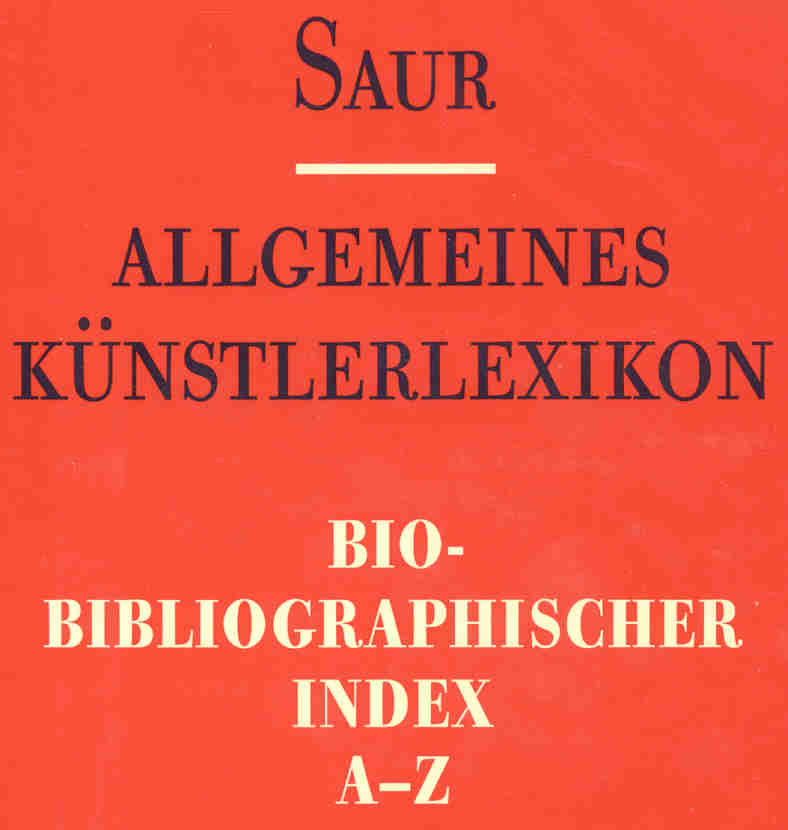The Supplemental Register
All encyclopedias built along alphabetical principles have one limitation: they require key terms. In the case of the Allgemeines Kuenstler-Lexikon it is the artist’s name. Geographical or chronological connections, stylistic or historical ties can only be discovered through research in the individual biographical texts. Questions about any particular country and the artists it produced or sponsored cannot be answered without much time consuming research and, conversely, neither could questions about artists, painters, architects, sculptors, and the countries they worked in.
To make this kind of cross country, cross cultural research easier the publisher and the editors decided after publication of the encyclopedia’s 10th volume to compile a register that complements and enhances the Allgemeines Kuenstler-Lexikon. This register consists of two parts:
1. Teil, Länder (Part 1, Countries) and
2. Teil, Künstler Berufe (Part 2, Artists’ Professions.)
The entries in Part 1 begin with individual countries, in alphabetical order, with Ägypten (Egypt) and end with Zaire. Last is a list of artists without country affiliation. Within each country the professions are listed, i.e. architects, painters, sculptors. Under each profession the artists’ names are given in chronological order with the volume and page number where they may be found in the Allgemeines Kuenstler-Lexikon.
In Part 2 the first level is the artists’ professions, with countries as the second grouping and artists’ names following. Thus all architects, painters, sculptors, etc…, are grouped together and subdivided by their professions.
For every ten volumes of the Allgemeines Kuenstler-Lexikon one volume each of Part 1 and Part 2 are published.
By the time twenty some volumes of the Allgemeines Kuenstler-Lexikon, up to the letter D, had been published, covering more than 110,000 biographies, it became obvious to the editors that a means had to be found for researchers to quickly and easily obtain basic information. More than half the enquiries continuously coming into editorial offices have to do with a few precise items of biographical information: date and place of birth or death, verification of artists’ names, which over the centuries had been dealt with in sometimes arbitrary ways. And so the red, 10-volume, Bio-Bibliographical Index (Bio-Bibliographischer Index) came into being.
The entries in this index consists of the artist’s verified name, profession, birth and date information (when available), and an abbreviation for the countries where the artist worked. This is followed by an open book symbol that contains abbreviated citations to other encyclopedic works where information on the artist may be found. There are frequent cross-references that are particularly helpful in navigating the variety of transliteration and transcription possibilities for many names.
Conclusion
The Allgemeines Kuenstler-Lexikon is a unique work. Even in its incomplete form it is a singular achievement. It brings together all that is known of artists of the visual arts of all regions and all periods and presents that enormous body of knowledge in a system of precise, accurate, inclusive, authenticated biographies. This has never been available before and its value in time, effort, and trust to historians and art professionals is incalculable.
The value to the layman is different, of course (the German reading layman, that is). But it is fair to say that anyone who has browsed through some of the Allgemeines Kuenstler-Lexikon biographies will look at a work of art in new way and see the man, or the woman, behind it.
He may look at Dürer’s Praying Hands or his Young Hare and admire the elegance of line and delicacy of brushstrokes, and he will think of the great artist, the theoretician on geometry and human proportion, the humanist who wrote his books in the in vernacular German rather than in Latin, and he will probably chuckle remembering Dürer, the clever business man. Dürer, godson of a printer, was the first artist to have representatives throughout Europe to sell impressions of his copper engravings. He died wealthy.
Visiting Florence and gazing up at Brunelleschi’s dome he must marvel at the mind who conceived a dome made of bricks reaching 83m to the sky. Brunelleschi was an “inventore,” a goldsmith, a sculptor, an architect, a mathematician, a builder, an inventor, the quintessential Renaissance man.
And looking at one of Canaletto’s sparkling cityscape of Venice, of the Grand Canal with the hump of the Rialto and Saint Mark in the background, each palazzo distinct and recognizable, he cannot help but muse wryly that Canaletto’s paintings were the postcards of this time, bought by visiting princes and wealthy merchants to take home. (Aah, but to get such a postcard.)






No comments:
Post a Comment